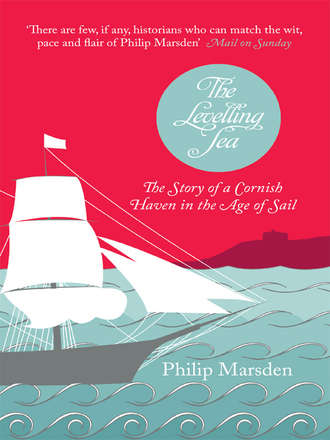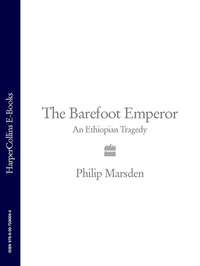
Полная версия
The Levelling Sea: The Story of a Cornish Haven in the Age of Sail
CHAPTER 7
The uncanny failure of the Spanish to land their forces, repeated again and again, stamped itself on English identity for centuries to come. The weather had played its part in 1588 and had helped turn back two subsequent Armadas. What it took away from the English in terms of naval might, it gave back to them in mystique. But to speak of luck is to fail to understand the divine hand half hidden in the breeze and in the mysterious folds of the sea. A.L. Rowse was echoing a widely held belief when he wrote of the ‘anti-Catholic, anti-Spanish winds of the Channel’.
The moment in 1591 when Sir Richard Grenville died off the Azores, with his crippled Revenge surrounded by enemy ships, the winds freshened to a gale. Soon fish were being hurled against the Spanish topsides. Grenville, muttered the watching Spanish (according to the Dutch traveller and historian Van Linschoten), ‘was raising all the Devils of Hell from the bottom of the sea’. Van Linschoten also reported that, after all these years of war between Elizabeth I and Philip II, the Spanish believed that ‘fortune or rather God was wholly against them’ while the English, ‘seeing all their enterprises do take so good effect, that thereby they are become lords and masters of the sea’.
The same spirit fills the second volume of Richard Hakluyt’s anthology. Amidst the epic tales of sea fights, the taking of Spanish prizes and the firing of their carracks, is a strange presumption of eventual triumph. ‘It is evident in all the writings of that period,’ wrote the literary historian Anne Treneer, ‘that English sailors relied consciously or unconsciously on a force external to themselves, which made them invincible.’
That English seafaring emerged so suddenly and so effectively contributed to the sense of destiny. From the high ground of the 1890s the jingoistic historian James Froude pointed to the early Elizabethan years: ‘the bark of the English water-dogs had scarcely been heard beyond their own fishing-grounds, and the largest merchant vessel sailing from the port of London was scarce bigger than a modern coasting collier’. But within a couple of decades, ‘these insignificant islanders had struck the sceptre from the Spaniards’ grasp and placed the ocean crown on the brow of their own sovereign’. For puff-chested British imperialists, the improbability of Elizabethan sea victories helped explain the improbability of Victorian global supremacy.
Conceptions of the sea itself shifted during the late sixteenth century. In the early years it remained something unimaginably vast, a watery infinity, the most visible example of God’s power. But by the death of Elizabeth I, some of that power had been brought to earth. Those men who crossed the ocean removed a little of its dread, as they returned with worldly wonders, strange new plants, sparkling jewels and silver, and wondrous tales of golden cities.
In the work of Shakespeare, which coincided with England’s maritime blooming, references to the sea increase over the years. To begin with, it was used simply to convey great size. In the early poem Lucrece: ‘“Thou art,” quoth she, “a sea, a sovereign king”’, or in Romeo and Juliet: ‘My bounty is as boundless as the sea / My love as deep.’
Whether Shakespeare went to sea or not is a question that has been much discussed. In 1910 a professional seaman Captain Whall trawled the plays for technical language and published his thoughts in Shakespeare’s Sea-Terms Explained. Amazed at Shakespeare’s accuracy, he was persuaded that the playwright spent time at sea (possibly during the seven years of his adult life for which there is no biographical material). How else, wonders Whall, could he have learned such a supple command of terms if not aboard ship?
While much of his sea imagery is sophisticated, there are phrases in the plays that do not suggest sustained experience at sea: ‘He, that hath the steerage of my course, / Direct my sail!’ (from Romeo and Juliet) is not how a mariner would use language. Describing the fleet in the prologue of the third act of Henry V, he reports that the sails ‘Draw the huge bottomes through the furrowed sea’ – ignoring the intricate mechanics of sailing apparent to those on board; and those agricultural ‘furrows’ suggest swells seen not from on deck but looking down from a cliff-top.
Shakespeare’s precise use of sea-terms, where they occur, probably came by the same route as everything else in his writing, via an astonishing ear for language. As the port of London became a-bustle with ships and sailors and talk of voyages and far-off places, so his work filled with the drama of the sea, with wharfside tales of storms and distant shores, and the briny spirit of the age. All his foreign towns were ports. According to G. Wilson Knight’s intricate study of marine reference in Shakespeare, ‘his one general rule was that all distant towns are by the sea side; and if not they should be.’ By the time of The Tempest, written in the last decade of Elizabeth’s rule, the sea is not just a source of metaphor, but a conduit for the exotic. Ships come back with reports of ‘men of Ind’, the ‘Arabian Phoenix’, Tunis and Carthage. Wilson Knight concluded that, in Shakespeare’s work, ‘fate is to be equated with the elements, any human enterprise with the ship’. In the plays, ocean-going craft tend to be hapless pawns of the weather, and storms and shipwreck their frequent lot. Putting yourself in a ship on the sea is the same as embarking on a course of worldly power: those who do each are risking tragedy.
John Killigrew sat in his cell in the Westminster Gatehouse, a tragic character left alone to contemplate the wreck of his own life. It was June 1598. He had been there for over four months and was already suffering. The damp stone stiffened his joints. He had pawned his horse and his clothes for food, and there was little left. He had glimpsed his wife and some of his eleven children at the prison window but now they had returned to Cornwall. His only distraction, as he wrote in the surviving letters, was to dwell on all ‘his past vanities’.
Fifteen years had passed since he left Elizabeth’s court. For several decades before that, under the protection of his uncles Henry and William, he had played an anonymous part in the Queen’s wider circle. Even there his reckless greed helped him through a large part of his wife’s estate, forcing her to sell £3,500 worth of her land. But it was at Arwenack, as governor of Pendennis, during the great rise in privateering in the 1580s, that the sea spread its glitter before him.
‘It is true’, he reflected from prison, ‘that a golden prey enticeth many a man.’
Locked in the Gatehouse, he wrote a petition, outlining a plan to settle his debts. Gather a committee, he pleaded, call my Lord Anderson, Sir Anthony Mildmay, Sir Edward Dyer, the old friends from his days at court – Sergeant Heale, Mr Poynes (clerk of the Queen’s Kitchen) and Mr Moore (sheriff of London). Ask them to tot up the amounts owed, then he would mortgage his remaining estates. Given time, he could meet all legitimate demands. Had he not already settled the £1,000 he owed Her Majesty?
But forty years of bullying and coercion were catching up with him. Tenants were refusing to pay rent. The sheriffs of Cornwall, in gathering debt from his property, had helped themselves to another £1,000. ‘My enemies and creditors,’ he complained, ‘are malicious towards me.’ He was unable to defend either his estates or his reputation. Down on the Galician coast, in La Coruña, no one was surprised to hear the false rumour that, following Killigrew’s arrest, he had been executed as a traitor. They were convinced like many others that Killigrew, desperate and renegade, had secretly turned Pendennis Castle for the Spanish.
Whether he had can never now be proved. But like his forebears, he was a proud Protestant. Only weeks before his arrest, a pirated ship from Waterford had fallen into his hands. When its cargo was discovered by Killigrew’s agent to be Catholic missals, beads and relics bound for England, they were publicly burned in Penryn market. The Killigrews had, in their own wayward manner, upheld principles – like Shakespeare’s ‘sanctimonious pirate’ in Measure for Measure who takes a wooden board to sea with the Ten Commandments written on it, or rather nine, as he has scrubbed out Thou shalt not steal.
John Killigrew remained in prison while officials picked at the bones of his Arwenack estates. He grew more and more concerned for the upkeep of his wife and children. In 1600 Queen Elizabeth ‘most graciously pyttieng the extremities whereunto the said John Killigrew hathe of late fallen’ allowed him home for three months.
So he went back once more to Arwenack. In forty years, through its high-ceilinged rooms and banqueting hall, had passed countless adventurers and riches. But the estate now lacked the land to support itself. On the headland to seaward of Arwenack, and visible from the curtilage, Pendennis Castle was, for the first time, not governed by a Killigrew. As it had once been the agent of their rise, so its neglect had marked their downfall. The new governor, Sir Nicholas Parker, was immune to the temptations of the sea. He was a soldier, veteran of campaigns in the Low Countries. As soon as John Killigrew was removed, he hastened to restore the castle. Falmouth was regarded as one of the country’s most vulnerable corners. ‘There are two places in these western parts,’ Sir Francis Godolphin wrote to Burghley, ‘where, if not fortified, the enemy may prevail; the harbours of Falmouth and Scilly.’ Elizabeth addressed Sir Nicholas Parker directly, suggesting in a letter that he was having to start from scratch: ‘We committed to you the charge of our fortifications intended to be built upon the haven of Falmouth.’
Parker took to his duties with zeal. He employed 400 men to dig ditches, curtaining the castle with earthworks and look-out posts. He applied for new guns to add to the one that remained in the castle. In examining the castle grounds, he spotted a more effective land boundary and annexed fifty acres of Arwenack land. Short of timber, he felled 1,700 of Killigrew’s trees.
John Killigrew complained, but he could do little. Parker was a proven hero. Richard Carew considered that Pendennis’s ‘greatest strength consisteth in Sir Nicholas Parker, the governor’. Tacitly Carew admonished the Killigrews’ years of local bullying, in contrast to Parker ‘who demeaning himself no less kindly and frankly towards his neighbours … than he did resolutely and valiantly against the enemy when he followed the wars’. His presence and leadership were exemplary. At Pendennis he had two companies of 100 men, as well as being colonel-general of all forces in Cornwall. He commanded, gushed Carew, ‘not only their bodies by his authority, but also their hearts by his love’.
John Killigrew died in prison in 1605. His heir – the fourth John Killigrew – inherited the house and little else. He had married a lively woman named Jane Fermor whose inheritance managed to give a little respite from his father’s debts. But according to all accounts, she caused him much misery. At Pendennis Castle, succession had a new heredity. When Sir Nicholas Parker died, his son became governor and added a further humiliation to the fallen Killigrews. It was this man, according to the Killigrew chronicle, who ‘first debauched’ Jane Killigrew.
With the death of Elizabeth I and the arrival of James I in England, travelling overland from Scotland in his great cavalcade, came a radical shift in official policy to the sea. Gone was support for those who pursued sail-driven adventure. The state would no longer tolerate mavericks like the West Country sea-barons for whom the Channel was a free-for-all, who made a grab for whatever ships passed within their reach. King James appeased the Spanish with an instant treaty, locked up Sir Walter Raleigh, banned the practice of privateering, and presided over a Navy that, though generously funded, rotted like some diseased shrub from the top down. The number of admirals, who rarely went near the water, soon exceeded that of serviceable ships, while crews went unpaid.
James had little understanding of the sea, finding that his attempts to bring order to it had exactly the opposite effect. Released from naval service, unable to sail on privateers, tens of thousands of seamen were now idle. Nothing ashore could match the returns of their life at sea, so they went back. The first years of James’s rule witnessed a rise in English piracy never seen before or since. By 1608 an estimated 500 English pirate ships were at large, ten times as many as in the time of Elizabeth. Brutalised by war, emboldened by their nautical skills, the bandit mariners – the finest pirates in Europe – infested the seas, spreading the spirit of lawlessness from the English Channel, out across the North Atlantic and down into the Mediterranean.
The seamen of the West Country were well represented in this great flowering of robber enterprise. In Plymouth, the mayor complained of the ‘great number of sailors, mariners and masterless men, that heretofore have been at sea in men of war [and their] intolerable outrages’. In 1605 the Jonas was seized off the Isle of Wight with £10,000 of lawns and cambrics. Over the coming months, the Jonas was sailed westward, stopping off to flog its cargo, a travelling bazaar of looted cloth. At Helford, numerous bales were taken ashore, carried to Penryn and sold openly in the market.
In Devon and Cornwall the pirates had nothing to fear from the authorities. Richard Hawkins, son of Sir John, and Hannibal Vyvyan – respectively vice-admirals of Devon and South Cornwall – themselves benefited from piracy. They sold pardons to the leaders and took generous bribes for allowing plundered goods to be sold. Tolerance of piracy spread beyond the West Country, along the coast and right up the hierarchy of the Navy, to the Lord High Admiral, the Earl of Nottingham.
If piracy and privateering were the principal blemishes in the emergence of England as a maritime power, naval corruption came a close second. In the final years of Elizabeth’s reign some ingenious scams appeared in the service. Finding no check, they multiplied. James’s regime of official profligacy encouraged naval leaders like Sir Robert Mansell (treasurer of the Navy) and Sir John Trevor (surveyor of the Navy) to help themselves to Crown supplies, and their example was imitated down through the ranks. Everything, from cordage and spars, canvas and crews, to ships themselves, was written in the books at vastly inflated quantities. As the actual fleet shrank, so the Navy’s ledgers recorded a phantom version of itself, growing larger with each passing month. When at last the Earl of Northampton forced a public inquiry – at which the full extent of corruption was revealed – the King did little more than wag a beringed finger at Mansell and Trevor. Likewise, when Hannibal Vyvyan was summoned from Cornwall, he too was let off. Holding pirates like Captain Jennings to ransom in the Helford river, allowing the release of Robert Duncomb at Falmouth, merited a summons, but no penalty.
Strangely, among all the complaints of wrongdoing in the early years of James’s reign, in the State Papers and Acts of the Privy Council and Star Chamber, even the extensive account of reformed pirate Sir Henry Mainwaring, the name of Killigrew is nowhere to be seen. The fourth John Killigrew, it turned out, was a stickler for the law. The picture of his own father dying bankrupt and alone in prison convinced this John that it was worth following the path of legality. He spent a great deal of time in litigation – riding up and down to London, attending courts first for his divorce from Jane, then lobbying for a scheme that he hoped would re-establish his family’s position.
On the northern boundary of what little land remained to Arwenack – just half a mile along the coast from the manor – lay Smithwick Creek. There above the low cliff, where a stream cut back into the soil and splashed to the shingle, stood the lime-kiln. A small inn had been built there, too, to provide for visiting crews – the single seed from which the port was about to grow.
According to the Killigrew family chronicle, the idea had been Walter Raleigh’s. Returning from the Caribbean in 1595, he put into Falmouth. His ships carried none of the journey’s hoped-for treasure, but he did bring tales of glittering cities on the Orinoco and the promise of future expeditions to discover them. In Falmouth, he sent his men to the single inn at Smithwick while he himself dined just along the shore with the Killigrews.
Raleigh was a mariner at heart and he had an instinctive attraction to Falmouth’s natural merits, its sheltering headlands and network of deep-water creeks, its position far out towards the Western Approaches. Now he spoke of Arwenack’s potential as a staging-post in the coming age. Old John Killigrew was in no position to pursue it – an outlaw, laden with a lifetime of debt and felony. But his son picked up on it. The chronicler, who wrote with scorn about his forebears, spoke of the fourth John Killigrew as ‘a sober good man’. His misfortune was the legacy of his father and grandfather. He had been forced into an ‘unfortunate’ marriage with Jane Fermor who had brought £6,000 to the family. But her adultery and the ensuing divorce made it a costly dowry. Countless trips to the archbishop’s court in London did little for Killigrew’s health and ‘quite ruined his estate’.
John Killigrew poured his energies into making money. He was the first at Arwenack to understand the basic rule of business, that it is better to offer people a service than rob them, better to victual ships than plunder them. And he knew that, by dint of geography, inheritance and timing, he was sitting on something priceless. For despite the piracy and corruption of King James’s court-bound regime, peace with Spain had led not only to a rapid increase in overseas trade but to a revival of the question of colonisation. Traffic through the Channel – Dutch and English, commercial and colonial, legal and illegal – was growing rapidly. John Killigrew seized his chance. He presented a petition that, with the Killigrews still well represented at court, was approved by King James. It was a modest beginning for a great port: permission to build four inns on what remained of his land.
The scheme was not without its critics, at least locally. The burghers of Penryn had nurtured a hatred for the Killigrews ever since the destruction of Glasney College. More and more ships took shelter off Arwenack land, rather than sailing up to Penryn. So when Jane Killigrew sought sanctuary from her estranged husband, Penryn was where she fled. She in turn presented the town with a 2-foot-high, silver loving-cup which is still borne around the town streets as part of the mayor’s parade. Jane Killigrew’s grateful message can be seen running around its rim: To the town of Penryn when they received mee that was in great misery.
Конец ознакомительного фрагмента.
Текст предоставлен ООО «ЛитРес».
Прочитайте эту книгу целиком, купив полную легальную версию на ЛитРес.
Безопасно оплатить книгу можно банковской картой Visa, MasterCard, Maestro, со счета мобильного телефона, с платежного терминала, в салоне МТС или Связной, через PayPal, WebMoney, Яндекс.Деньги, QIWI Кошелек, бонусными картами или другим удобным Вам способом.






